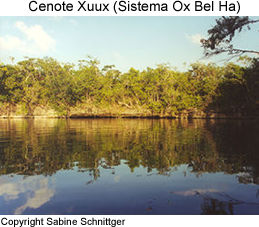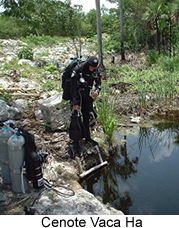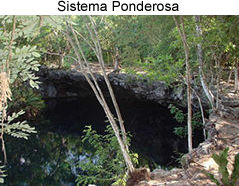DIVE SITES
The majority of the 70 cave systems are concentrated along the Yucatan Caribbean coast between Puerto Aventuras and the Tulum surroundings. From the mid-80s to the present, over a million feet of cave passages have been discovered. This represents the world's best and most extensive cave diving area. Three of the largest water filled caves are located here: 
Ox Bel Ha, Nohoch Nah Chich and Dos Ojos. More than 200,000 feet of surveyed tunnels have been explored in these cave systems. You will also find the longest underwater stalactite, Tunich Ha, here. Tunich Ha measures 42 feet and is found in Sistema Chac Mol. However, one of the most unique aspects of these cave is the halocline phenomenon. This occurs when salt water penetrating though the limestone from the nearby Caribbean meets with the fresh water creating a magnificent visual affect. For many, Yucatan's underworld not only offers great scenery of unspoiled beauty, but also a large variety of dive sites representing all kinds of different challenges for both the newly certified and the most experienced cave diver alike.
Why dive in the Yucatan?
 People from all over the world choose this area for their cave diving experience and training. The dive sites are easily accessed, offer shallow depths, and have good visibility, mild water temperatures and no apparent flow.
People from all over the world choose this area for their cave diving experience and training. The dive sites are easily accessed, offer shallow depths, and have good visibility, mild water temperatures and no apparent flow.
From the central location in Akumal, the dive sites are an easy 15 - 30 minute drive. Most dive sites are privately owned and charge a minimal entry fee ranging between $5 to $10 dollars. At some of the sites you will find rest rooms and changing rooms. Most sites have a platform and a ladder in which to enter and exit the water, with parking near by.
The average depth of the cave systems is 40 ft (12 m). This allows for longer bottom times and shorter deco stops. This plays an ever greater importance for those divers coming to the area for cave training. Several dives can be made per day with a greater amount of bottom time to practice skills.
The visibility is excellent year round. You will be able to see as far as your light will shine.  In addition, the weather conditions do not affect the cave systems as they do in other parts of the world. During the rainy season, we have some tanic acid (decaying vegetation) which seeps through the limestone giving a brownish color to the water close to the ceiling or around air domes. During the summer, you will find an algae bloom at some cenotes. This is due to the surface water becoming warmer than at depth. This adds to the beauty of these cenotes creating a green cloud close to the surface. Once you descend, you can see the this cloud above you.
In addition, the weather conditions do not affect the cave systems as they do in other parts of the world. During the rainy season, we have some tanic acid (decaying vegetation) which seeps through the limestone giving a brownish color to the water close to the ceiling or around air domes. During the summer, you will find an algae bloom at some cenotes. This is due to the surface water becoming warmer than at depth. This adds to the beauty of these cenotes creating a green cloud close to the surface. Once you descend, you can see the this cloud above you.
The water temperatures stay around 76°F (26°C) year round. Divers from around the world come here to dive the cave systems which are considerably warmer than other caves in different areas.
As with any river system, which is what our cave systems are, water is moving eventually reaching the ocean. However, because the terrain is so porous and there are a lot of conduits, water seems as if it is not moving at all. In reality, it is just being dispersed. From a training point of view, a lot of emphasis is put on buoyancy skills since we don't have flow to assist you. We believe that it is easier to master the different states of buoyancy in this type of environment before moving on to an environment where there is flow.
Cave Features
The phrase "seen one cave, seen them all" does not apply to any of the caves around here. Each cave has its unique and diverse characteristics and personality. Even within the same system, one can expect to see completely different features in the various passages. Some of the incredible features you will see are stalactites, stalagmites, columns, flow stones, rimstone dams with cave pearls, calcite flags and travertine pools, to name a few. And in most caves, you will be able to view a halocline, giving a beautiful effect to the dive when combined with your lights.
DIR México/ Pto. Aventuras
Quintana Roo, México 77733
Copyright©2001 - 2019 - All rights reserved
